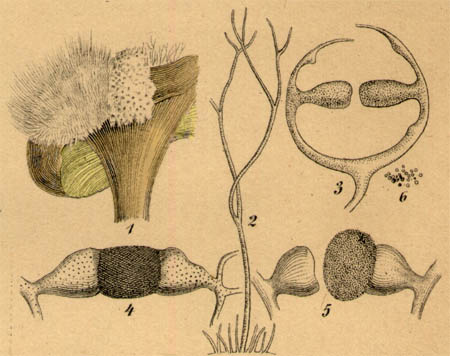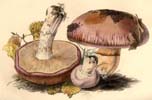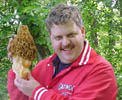|

|
 As you can see, Blakeslee made a promising beginning, doing research on fungi, but unfortunately strayed into the world of plants. Species of Mucorineae produce huge, warty spores called zygospores, which is why that phylum of the fungi is called Zygomycetes. Blakeslee showed that his different cultures of Mucorineae could be separated into two groups, which he called + and -, as there was no visible difference between them. Any member of the + group would form zygospores with any member of the - group, but not with any other member of the + group; and likewise any member of the - group would form zygospores with any member of the + group, but not with any other member of the - group. This demonstrated the existence of "sexes" in the Mucors (although we now call them mating types) and established once and for all that sex does occur in the fungi.
As you can see, Blakeslee made a promising beginning, doing research on fungi, but unfortunately strayed into the world of plants. Species of Mucorineae produce huge, warty spores called zygospores, which is why that phylum of the fungi is called Zygomycetes. Blakeslee showed that his different cultures of Mucorineae could be separated into two groups, which he called + and -, as there was no visible difference between them. Any member of the + group would form zygospores with any member of the - group, but not with any other member of the + group; and likewise any member of the - group would form zygospores with any member of the + group, but not with any other member of the - group. This demonstrated the existence of "sexes" in the Mucors (although we now call them mating types) and established once and for all that sex does occur in the fungi.
This is the work that established for once and for all that sex occurs in the fungi, and established the existence of mating types in fungi.
 Glossary |  Mushrooms |  |  People |  Newsletter |  Events |